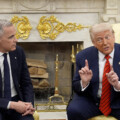New exclusive polling from Abacus Data reveals a dramatic shift in Canada’s federal election landscape, with the Liberals surging ahead as voter priorities realign around two competing narratives: the threat of Donald Trump and the desire for systemic domestic change. In a discussion with The Hub, David Coletto, CEO of Abacus Data, unpacked the latest trends shaping the campaign.
Here are three key takeaways from their discussion:
- The Liberals have overtaken the Conservatives for the first time in years: The Liberals now hold a one-point lead in voter intentions over the Tories—their first numerical advantage in years. Since Trudeau’s departure, the Grits have gained 18 points while the Conservatives dropped nine points and the NDP collapsed to just 11.
- The election hinges on competing narratives—Trump’s shadow vs. demand for change: A striking 56 percent of voters now say their ballot will be decided by which party can best handle Donald Trump. This framing dramatically favours the Liberals, who lead by 25 points among “Trump-focused” voters. Meanwhile, the Conservatives dominate by 30 points among those prioritizing “change.”
- Voter anxiety has shifted from scarcity to precarity: The pandemic-era “scarcity mindset” (fears about inflation, housing, and health-care access) is giving way to a “precarity mindset”—deeper anxieties about long-term stability, fueled by Trump’s threats to Canada’s sovereignty, AI disruption, and climate change. This shift has moved voters from zero-sum individualism toward collective security concerns, benefiting leaders like Mark Carney, whose technocratic background projects steadiness. Abacus’s “precarity index” shows that those most worried about the future are flocking to the Liberals, while Conservative leader Pierre Poilievre struggles to sell himself as a capable ship “captain” in turbulent waters.
The liberals surge ahead
Fueled by Justin Trudeau’s resignation and growing anti-Conservative consolidation, the Liberals now hold a one-point lead over the Conservatives in voter intentions, marking the first time Abacus has had them numerically ahead in years.
This surge, which began after Justin Trudeau’s resignation announcement, has seen the party gain 18 points in just two months. The Conservatives, meanwhile, have dropped 9 points, and the NDP fell to just 11 percent support, from 18 percent in December. The Liberals are now leading the Conservatives in Ontario, Quebec, and Atlantic Canada, with British Columbia statistically tied.
While the Conservative vote has remained stagnant at historic highs, left-leaning Canadians are rallying around the Liberals, abandoning parties like the NDP and Bloc Québécois.
“If I told you the Conservatives could lose an election while still getting 40 percent of the vote…it’s a remarkable consolidation that the Liberals have done in vacuuming up a lot of that, let’s call it ‘not conservative vote’ out there,” said Coletto. Still, the pollster maintained that this is a competitive election.
Trump vs. change: The defining narratives
The election’s narrative is increasingly split between two competing frames: whether voters prioritize a party’s ability to handle Donald Trump’s tariffs or their capacity to deliver change. Abacus polling shows 56 percent of voters now see Trump as the dominant issue, up from a minority a month ago. This shift has benefited the Liberals, who lead by 25 points among “Trump-focused” voters, while the Conservatives hold a 30-point advantage among those seeking “change.”
Coletto explained that Poilievre’s strategy—hammering affordability and rejecting the Trudeau era—aims to keep the election centered on change. However, he faces a perceptual challenge: a majority of Canadians believe he would have voted for Trump in the U.S. election, undermining his ability to compete on the Trump-focused frame.
Coletto argued that the desire for change, however, is much stronger than during the 2021 election.
“It just needs to be expressed and somehow articulated in a way that people are focused on that and not on Trump,” he explained. “[I’m] not sure it’s possible, but I think that’s the outcome they need to happen if [the Conservatives are] going to ultimately be successful.”
The Conservatives’ dilemma, he added, is whether to double down on change or attempt to reassure voters on the Trump question—a risky move given their base’s Trump-sympathetic faction. For now, Poilievre seems to be betting on the former.
From scarcity to precarity
Finally, Coletto identified a deeper psychological shift shaping voter behaviour: the transition from a scarcity mindset (focused on immediate economic pressures) to a precarity mindset (fear of long-term instability). Inflation, housing shortages, and health-care gaps initially drove voters toward zero-sum thinking. But Trump’s threats—including tariffs and existential risks to Canada—have reoriented anxieties toward collective security.
“Precarity is about longer-term uncertainty,” Coletto said. “It’s not just ‘Can I afford groceries?’ but ‘Will Canada exist as we know it?’”
This major shift favours leaders who project steadiness, like Mark Carney, whose consistent net favourability (+11) since last week reflects voter trust in his technocratic resume.
Abacus’ “precarity index” shows that Canadians who are most worried about the future are leaning Liberal. Poilievre’s challenge is to convince voters he can “captain the ship” through turbulent waters.
Generative AI assisted in the production of this story. If you are quoting from or referencing this episode, please refer to the audio to verify.








